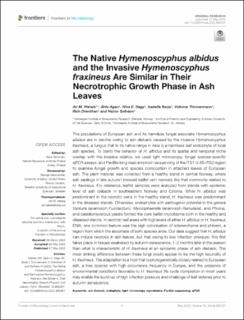| dc.contributor.author | Hietala, Ari Mikko | |
| dc.contributor.author | Agan, Ahto | |
| dc.contributor.author | Nagy, Nina Elisabeth | |
| dc.contributor.author | Børja, Isabella | |
| dc.contributor.author | Timmermann, Volkmar | |
| dc.contributor.author | Drenkhan, Rein | |
| dc.contributor.author | Solheim, Halvor | |
| dc.date.accessioned | 2022-10-11T07:33:48Z | |
| dc.date.available | 2022-10-11T07:33:48Z | |
| dc.date.created | 2022-08-30T11:22:34Z | |
| dc.date.issued | 2022-05-27 | |
| dc.identifier.citation | Frontiers in Microbiology. 2022, 13 1-14. | en_US |
| dc.identifier.issn | 1664-302X | |
| dc.identifier.uri | https://hdl.handle.net/11250/3025256 | |
| dc.description.abstract | The populations of European ash and its harmless fungal associate Hymenoscyphus albidus are in decline owing to ash dieback caused by the invasive Hymenoscyphus fraxineus, a fungus that in its native range in Asia is a harmless leaf endophyte of local ash species. To clarify the behavior of H. albidus and its spatial and temporal niche overlap with the invasive relative, we used light microscopy, fungal species-specific qPCR assays, and PacBio long-read amplicon sequencing of the ITS1-5.8S-ITS2 region to examine fungal growth and species composition in attached leaves of European ash. The plant material was collected from a healthy stand in central Norway, where ash saplings in late autumn showed leaflet vein necrosis like that commonly related to H. fraxineus. For reference, leaflet samples were analyzed from stands with epidemic level of ash dieback in southeastern Norway and Estonia. While H. albidus was predominant in the necrotic veins in the healthy stand, H. fraxineus was predominant in the diseased stands. Otherwise, endophytes with pathogenic potential in the genera Venturia (anamorph Fusicladium), Mycosphaerella (anamorph Ramularia), and Phoma, and basidiomycetous yeasts formed the core leaflet mycobiome both in the healthy and diseased stands. In necrotic leaf areas with high levels of either H. albidus or H. fraxineus DNA, one common feature was the high colonization of sclerenchyma and phloem, a region from which the ascomata of both species arise. Our data suggest that H. albidus can induce necrosis in ash leaves, but that owing to low infection pressure, this first takes place in tissues weakened by autumn senescence, 1–2 months later in the season than what is characteristic of H. fraxineus at an epidemic phase of ash dieback. The most striking difference between these fungi would appear to be the high fecundity of H. fraxineus. The adaptation to a host that is phylogenetically closely related to European ash, a tree species with high occurrence frequency in Europe, and the presence of environmental conditions favorable to H. fraxineus life cycle completion in most years may enable the build-up of high infection pressure and challenge of leaf defense prior to autumn senescence. | en_US |
| dc.description.abstract | The Native Hymenoscyphus albidus and the Invasive Hymenoscyphus fraxineus Are Similar in Their Necrotrophic Growth Phase in Ash Leaves | en_US |
| dc.language.iso | eng | en_US |
| dc.publisher | Frontiers Media S.A. | en_US |
| dc.rights | Navngivelse 4.0 Internasjonal | * |
| dc.rights.uri | http://creativecommons.org/licenses/by/4.0/deed.no | * |
| dc.title | The Native Hymenoscyphus albidus and the Invasive Hymenoscyphus fraxineus Are Similar in Their Necrotrophic Growth Phase in Ash Leaves | en_US |
| dc.title.alternative | The Native Hymenoscyphus albidus and the Invasive Hymenoscyphus fraxineus Are Similar in Their Necrotrophic Growth Phase in Ash Leaves | en_US |
| dc.type | Peer reviewed | en_US |
| dc.type | Journal article | en_US |
| dc.description.version | publishedVersion | en_US |
| dc.rights.holder | © 2022 Hietala, Agan, Nagy, Børja, Timmermann, Drenkhan and Solheim | en_US |
| dc.source.pagenumber | 1-14 | en_US |
| dc.source.volume | 13 | en_US |
| dc.source.journal | Frontiers in Microbiology | en_US |
| dc.identifier.doi | 10.3389/fmicb.2022.892051 | |
| dc.identifier.cristin | 2047120 | |
| dc.source.articlenumber | 892051 | en_US |
| cristin.ispublished | true | |
| cristin.fulltext | original | |
| cristin.qualitycode | 2 | |

